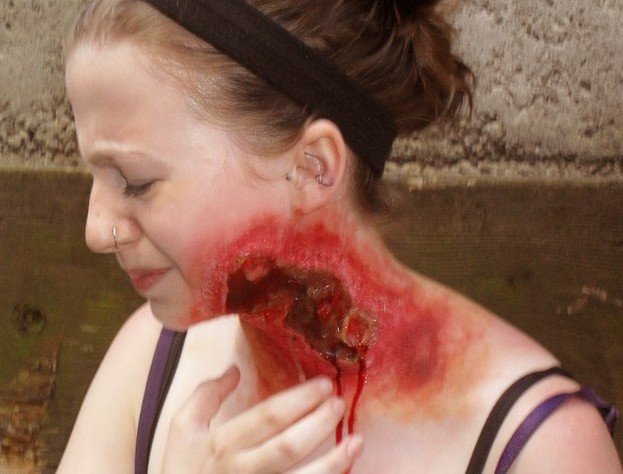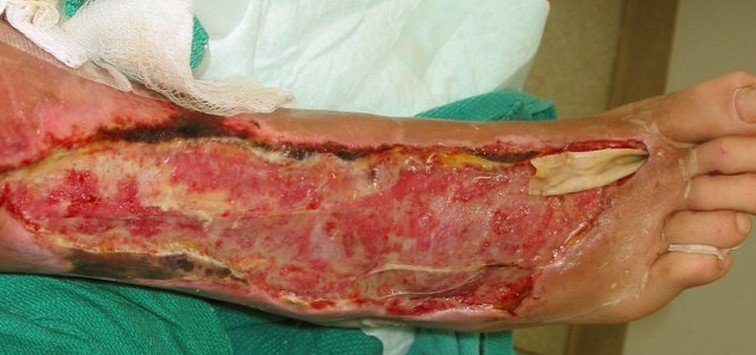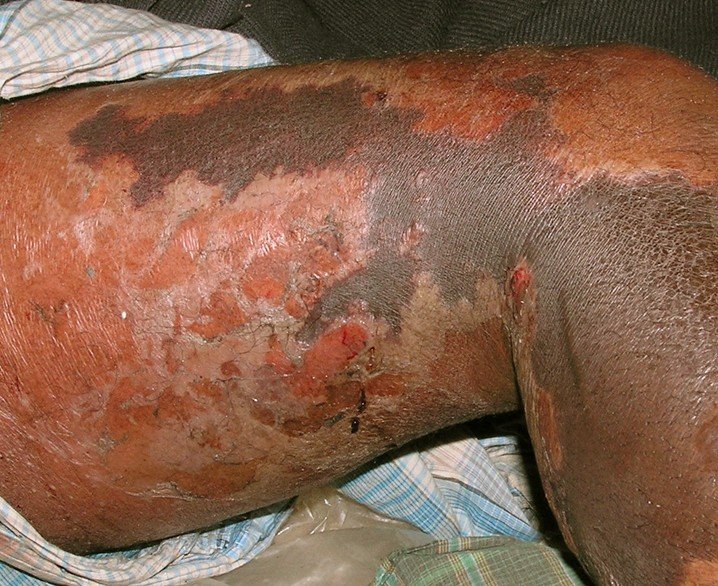Necrotizing Fasciitis
What is Necrotizing Fasciitis?
This medical condition is also referred to as the Flesh Eating Bacteria disease and it is very rare for a person to have this disease. It is a bacterial infection that is characterized by the breakdown of muscle tissue, fat, and skin. When this happens it looks as if the flesh has been eaten away, giving the disease its other name, flesh-eating disease. It is a very dreadful and severe disease and can target anyone anywhere. Necrotizing fasciitis life cycle is infection, growth, and quick reproduction. When you have these bacteria inside you the enzymes and toxins that are produced by the bacteria destroys the fascia (a layer of fibrous tissue) and tissues of your body causing the tissues to become gangrenous, which means death of soft tissue because of obstructed circulation. It is an infection that has a rapid course of progression along with a high mortality rate, which range from twenty-five to seventy-five percent. One in four people who get necrotizing fasciitis will die from this infecting.
Necrotizing Fasciitis Symptoms
Necrotizing fasciitis can be visible on the surface around any cut or bruise or when the bacteria star destroying the fascia that is near the skin surface. It can also be invisible under your skin. If it is under your skin it is hard to tell all of the symptoms. The symptoms that a person might experience can include:
- It will usually start out as a small red bump on your skin that is more painful that it should be for a wound that size.
- Having pain that is unbearable in the area that is infected and where there is active bacteria.
- Having nausea and vomiting.
- Diarrhea
- Lack of strength
- Experiencing confusion
- High fever
- Due to the confusion and other problems you may have an extremely low blood pressure.
- Due to the existence of the enzymes and toxins that are produced by the bacteria in your body you may be dehydrated.
- The area will start to swell, and become red causing you to experience in that area a burning sensation.
- Inflammation in the area when tissue death starts to occur
If it is not caught and treated in a matter of days the continuing infection will manifest as:
- As blue, purple, or white skin discolorations.
- Flakiness around the wound.
- Blisters that are deep, black, and oozing.
At this point you might become unconscious because you have gone into toxic shock.
Necrotizing Fasciitis Causes
There are many different bacteria that can cause necrotizing fasciitis. The infections can be caused by one or more species of bacteria at same site. There are currently two species that are commonly found in a hospital, which are:
- Methicillin-resistant Staphylococcus aureus (MRSA)
- Streptococcus pyogenes
When either of these bacterial infections happen the symptoms that the toxins released by the infecting bacteria activates the immune system so potently that the bacteria will wreak mass destruction on the tissues around the toxins. The attacks keep happening as the toxin circulates through your blood. Many times necrotizing fasciitis is caused by the same bacteria that cause infections like impetigo and strep throat.
A person can get necrotizing fasciitis when it enters your body. Some of the ways that it can enter your body can include:
- The bacteria can get into your body from having a trauma, surgery, cuts, touching anything that has the bacteria on it, burns, insect bite, and many other ways.
- You can also get it through wounds that come in contact with raw saltwater fish, raw oysters, or ocean water. This includes any injuries that you get from handling any sea animals like crabs.
- You can also get necrotizing fasciitis when you have gunshot injuries in your intestines, having tumors in your intestines, or having intestinal surgery.
- Having a bruise or muscle strain, even if there is no break in your skin
Diagnosis
Necrotizing fasciitis is diagnosed based on the symptoms that you are experienced and doing a blood sample test. The physician may also take a sample of the infected tissues for a biopsy. Many times physicians will confuse the symptoms of this disease with symptoms of other diseases, especially if it is spreading under your skin and cannot be seen on the outside. If this happens it can lead to a delay in treatment and possibly cause you to die.
Necrotizing Fasciitis Treatment
It is very critical that if you have necrotizing fasciitis that you get early treatment because the sooner you get treatment the more likely you will recover and be able to avoid any serious complications such as having to have a limb amputated or even death.
Some of the ways that necrotizing fasciitis is treated can include:
- Having surgery that will remove the fluids and infected tissues to stop the infection from spreading. When you have necrotizing fasciitis you will almost always need to have surgery. To control the spread of infection many times people will need to have several surgeries. In order to save your life the surgeon may have to remove organs or do amputations. Whether this is necessary or not will depend on where the infection has spread to and how severe the infection is. Because there is no vaccine available that can be used against necrotizing fasciitis, surgery is usually the option that is taken to remove the diseased tissue. Also, if the surgery to remove the infected tissues is done in the early stages when it was first diagnosed you would have a better change of surviving.
- Taking antibiotics to help kill the bacteria that are causing the infection and also to strengthen and buildup your immune system. They usually use a broad spectrum of antibiotics because many times the disease is resistance to antibiotics so that is why it is necessary to try several antibiotics.
- Doing procedures to treat any complications that come from having this infection such as treating the for breathing problems, organ failure, and toxic shock
- To help prevent tissue death and promote healing they may use hyperbaric oxygen therapy. This is the procedure that will help to increase their bloods oxygen level which can also help to promote healing, fight infection, and help prevent tissue death. During this procedure you will be in a closed chamber having one hundred percent oxygen pumped in at high pressure.
Is Necrotizing Fasciitis contagious?
Yes, it is contagious. One way that you can get necrotizing fasciitis is it is passed from person to person. It can happen if you touch the wound of an infected person without wearing gloves or protecting yourself so you do not get the bacteria on you. Contacting necrotizing fasciitis from another person is rare and will usually only happen when the person who has been exposed to the bacteria has chickenpox, an impaired immune system, or an open wound somewhere on their body.
Prevention
If you are in close contact with a person who has necrotizing fasciitis, you have an immune system that is weakened, or suffering from a chronic disease seek immediate medical attention if you notice any symptoms of necrotizing fasciitis. If you are a nurse or a care taker of a person who has this infection make sure that you are wearing the proper protection such as gloves, sterile gowns, etc. You should also make sure that you are properly washing your hands after treating their wounds. You should also make sure that if you are around anyone with this infection and you have an open wound or sore that you keep it bandaged so the bacteria cannot get in the wound or cut. If your physician is aware that you have been around someone who has necrotizing fasciitis they may give you a prescription for antibiotics to help decrease your chances of getting the infection. In addition to keeping any open sores or cuts bandaged you need to make sure that you are keeping them clean.
Necrotizing Fasciitis Pictures
Photos, Images and Pictures collection of the Necrotizing Fasciitis disease…



